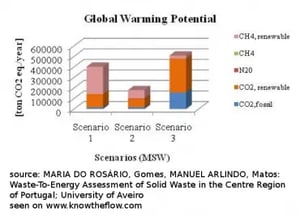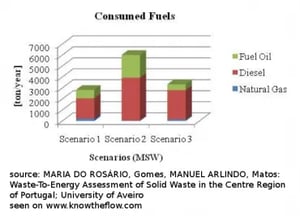Reduce, Reuse, Recycle – the waste imperative is as clear as it can get. What’s less clear, however, is what we should we do with the remaining stuff. Even the greenest society is, at a certain point, confronted with the unusable leftovers of consumption. What should happen to these? Treatment of the leftovers is a well discussed question and the answer relies on three big alternatives: incineration, dumping and composting. All three have pros and cons, some of which are apparent, others rather surprising.
In this article, let me introduce you to a life cycle assessment (LCA) that analyzes the main waste management options for municipal solid waste in detail. I have to tell you right away: none of the options is 100% environmentally friendly. Waste always has a negative impact on the environment. It can only be managed, never reduced to zero – unless you reduce the waste itself to zero. However, by modeling all material flows and their related environmental impacts, the life cycle assessment method gives us a clear picture of how the different options perform in many different categories.
Different Waste Management Inventories in Different Parts of the World
To begin with, I have to make a big distinction since the options discussed in this article are limited to industrialized countries. Yes, the developing world and especially the most dynamic emerging economies have enormous growth in the amount of waste to be dealt with – however, their means to cope with the problem are different. This is the reason today’s article deals with options available only to industrialized countries. But never mind. With a little patience, we’ll get the complete picture – next week’s blog will focus on waste management in the developing countries.
The LCA of interest was conducted by Gomes Maria do Rosario and Matos Manuel Arlindo from the University of Aveiro in Portugal. The two researchers compared three alternative waste management options (PDF) in central Portugal, an area where 1,8 million inhabitants generate 700,000 tons of municipal solid waste (MSW) every year (figures from 2006). At the moment, more than 90% of the waste is dumped in landfills. Only a small potion gets recycled (8.7%) or composted (1.2%).
Landfill vs. Refuse-derived Fuel vs. Incineration
The disadvantages of landfill dumping are quite apparent – it requires large areas, can contaminate soil and water, and emits climate-relevant methane, carbon dioxide and odors. In order to minimize the environmental damage, modern landfills are equipped with a waterproof ground layer and the means to capture leachate and monitor its quality. Leachate is the liquid that drips out of the waste. Moreover, aeration is provided in an attempt to minimize methane emissions (methane results from the anaerobic breakdown of carbon rich matter, which is organic material rotting with no available oxygen) – you pump fresh air into the dump to ventilate the waste. Alternatively, once the dump is full, the waste can be compressed and covered to capture the gas. This method is called landfill gas extraction and it actually promotes the production of methane. The gas can either be flared on the spot, used to generate heat and electricity (waste-to-energy), or processed to natural gas-like fuels.
Because of the disadvantages of landfills, the researchers, apart from the business-as-usual approach, analyzed two other scenarios. Scenario number two follows the PERSU II program goals which state that, by 2016, 36% of waste will be recycled (18% materials and 18% organic), mechanical-biological treatment will be used to recycle the organic components of the remainder, refuse derived fuel gets produced (18%) and a minor share of the waste goes to landfill (10%).
In scenario three, dumping plays only a minor role. Here, 20% of the material would be recycled and 25% of the organic waste recovered (7% household composting and 18% municipal composting). The biggest share of the waste goes to the incinerator (55%). Only the leftovers resulting from previous incineration and composting processes are dumped in landfills.
So which option performs best? Well, what makes LCAs better than any other environmental comparisons is their precision. A whole stack of impact categories are analyzed, and, as you can imagine, every category has a different winner. There is no final score. Too bad? Actually, the more detailed you analyze a phenomenon, the harder it will be to find a simple answer. If you are seriously investigating environmental effects, there is no universal answer most of the time. Much more, it all depends on your goals. You can find a more appropriate solution and you can drop a less appropriate one, depending on what you want to optimize. In this article, I look at five exemplary results: three impact categories and two figures measuring the overall energy consumption of the three waste management scenarios.
Incineration has Biggest GWP
One important impact category is the global warming potential (GWP). The GWP shows how much greenhouse gas will be emitted into the atmosphere in the medium run. As you can see in the diagram to the right, all the waste in Portugal’s Centre region causes roughly 150,000 – 480,000 tons of carbon dioxide equivalent greenhouse gas per year, depending on the way it is managed. And, in terms of global warming potential, scenario 2 performs best at only 150,000 t CO2eq/y. Scenario 2? Yes, mechanical-biological treatment, refuse-derived fuel, recycling and organic composting with a remainder of 10% to be dumped. At the other end of the scale is scenario 3, incineration, which will set free an enormous 480,000 t CO2eq every year, more than three times more.

Recycling + Refuse-Derived Fuel (Scenario 2) Consumes the Most Truck Fuel
However, in order to recycle it, the waste has to be collected and distributed, which consumes energy. Looking at the fuel consumption for waste transporters, it is the GWP winner, scenario 2, that scores worst. Roughly 5700 tons of fuel are needed, whereas scenario 3 only needs 3000, and scenario 1 even less at 2500 tons. If you compare the two diagrams, they give a contradictory impression. How can that be? Well, unlike consumer goods or food, transport is really just a small part of the GHG emissions for waste.

Another result that may seem a paradox at first sight is the toxicity. As I wrote earlier, waste disposal can harm soil and water. A standard impact category of life cycle assessment is human and ecotoxicity. Exactly these two categories show diverging results.

Biggest Water Polluter: Landfill (Scenario 1)
In terms of water pollution or aquatic ecotoxicity, the landfill option performs a lot worse than the other two options, as we would expect. Scenario 1 pollutes almost 500,000 m³ of water in one year. Scenario 3 generates one ninth of scenario 1’s water pollution, scenario 2 less than a third.

Most Toxic for Humans: Incineration (Sc. 3)
In contrast to this, the human toxicity category has a clear bad boy. Scenario 3 emits the most – more than double the emissions of scenario 1, almost three times more than scenario 2.
Summing things up, a sub-conclusion could be that the landfill option is not as bad we thought. What’s more, it is certain that the only sustainable option is waste prevention – through ecodesign, household composting, multi-use containers and little or no packaging. Once more, a life cycle assessment has proven that everything has its pros and cons.
In-Depth Efficiency-Analysis: Refuse-derived Fuel Plant vs. Incinerator
If you are dealing with waste management professionally, you may be interested in a presentation by Jasmin Kornau. This researcher from the Institute for Environmental and Biotechnology at the University of Applied Sciences Bremen compared the material and energy efficiency of two alternatives: a refuse-derived fuel plant with mechanical pre-treatment on the one hand, and an incineration plant on the other. Her slideshow (PDF download after registration) features detailed process maps and efficiency calculations.
Further Reading
- Seitz, Matthias: Life Cycle Assessment of Hazardous Waste Treatment in Bavaria – Modeling hazardous waste incineration processes using “ecoinvent Tools‟, bifa Environmental Institute, 16th Umberto User Workshop, 2011 (download PDF after registration here)
- Kornau, Jasmin: Comparison of various treatment options for municipal solid waste – Assessment of the material- and energy efficiency 15th Umberto User Workshop, 2010 (PDF download after registration)
- MARIA DO ROSÁRIO, Gomes and MANUEL ARLINDO, Matos: Waste-To-Energy Assessment of Solid Waste in the Centre Region of Portugal; Environment and Planning Department, University of Aveiro
Article image CC by knowtheflow.com, composed of images by llamnuds (CC 2.0 BY SA), meaduva (CC 2.0 BY) and Redwin Law (CC 2.0 BY)





